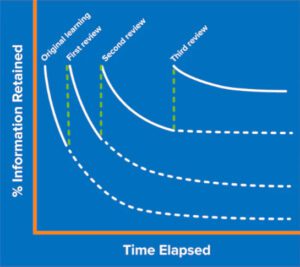Fun and Effective Training

In the 1970s when I was in my late teens, I was an apprentice floor covering installer working for an old taskmaster whose draconian management style came right out of the 19th century. I expected to be yelled at, humiliated, and threatened starting at 7:30 every morning. Needless to say, I HATED that job.
Why did I stay, you ask? I stayed because it was 1972 and jobs were not plentiful like they are today. In fact, I considered myself lucky to have that one. I was in that job for 12 years, and I felt pretty good when Attila the Carpet Layer eventually entrusted me to run his entire production department. Although I’m really in the weeds here, I provided this background so you would understand my belief that there’s a better way to train than yelling, humiliation, and threats. I also wanted to grab one of Atilla’s many inspirational phrases to set the stage for the purpose of this article.
In the first few years of gainful employment with Attila, the phrase “You should have learned that the first day you were here!” was heard multiple times each day. It got to the point where my coworkers and I would joke about the fact that there had been simply too much to learn on our first day.
That’s it. The story doesn’t get any better than that. However, within that overused phrase is a mistake that almost every employer makes in the course of training their team.
Since I previously referred to the 19th century, let’s go back there once more—to the 1880s, to be specific—and take a look at the work of Hermann Ebbinghaus, a German psychologist who was a pioneer in the study of human memory. His research led to what is commonly known as The Forgetting Curve, which relates forgetting to the passage of time. OK, we all pretty much know that our memories fade over time, right? Of course. But The Forgetting Curve is basically a graph that demonstrates just how much we actually do forget over a given period of time.
What’s most important for the sake of this article is the fact that there is a way to substantially slow down memory loss, or dare I say, there’s a way that our employees can actually retain what they’ve learned. With this, we can ensure that the time we spend training doesn’t have to result in our workers forgetting what we told them just a few days later.
The Forgetting Curve shows us that by reviewing what’s been presented at spaced intervals, we can flatten the forgetting substantially and actually have the information that’s been learned become knowledge. What does this mean to you, the business owner or manager? It means that if you train on a subject once, you’ve essentially gone through the motions but wasted your time. Sure some training is better than none at all, but if you want the full effect of that training, you need to review the information not once, not twice, but as many as three or more times for the information to become knowledge.

The Forgetting Curve
Let’s put this into a practical application. Imagine what would happen if you selected one hour each week for training, let’s say Tuesdays from 7:00 to 8:00 am. After picking out the learning objectives for the first week, you then clearly and concisely train around those learning objectives, spending about 40 minutes presenting the information. The next 10 minutes would be spent testing the learners on how well they absorbed what you instructed. The test would be kept short, with no more than about a half-dozen questions. The last 10 minutes would be spent reviewing the test.
The purpose of the test is twofold. First, it’s to make sure the way the material was presented resulted in each student learning the information. If you have 10 employees in the class and all 10 get a question wrong, that’s a pretty good indicator that you failed in the delivery of the information and need to revisit it. The second reason for testing at the end of training is simple: If people know they will be tested, they’re going to pay just a little more attention during the training. Now, this isn’t supposed to be one of those “gotcha” tests where you pass with 70% and never know what you got wrong. Far from it. The review period is to ensure that every person thoroughly understands the material that’s just been presented. And you don’t stop the review process until this is the case.
Let’s now take this a step further. You trained your team clearly and concisely on week one. You tested and reviewed to make sure everyone understood the material. Week two starts with the next step in flattening the curve, which is spending the first 10 minutes reviewing the learning objectives from week one. Then, and only then, do you spend the next 30 minutes training on week two’s learning objectives. And once again, the last 20 minutes is spent testing and reviewing that week’s material.
This training method is repeated each week until the final week when there is no material presented. Instead, that week is spent entirely on testing and reviewing, using the test questions from previous weeks’ tests. At this point, do you think your team actually retains a substantial amount of what you’ve taught them? Of course they do. How do I know? I used this method in my own company, and the results were incredibly successful. Without a doubt, I had the best trained team on the planet! (OK, maybe that’s a little bit of an exaggeration, but they were darn good.)
There’s one more element that makes this fun for the employees. We turned the final week’s test into a game that I called Beat the Boss. Here’s how it worked: I would come to that final week with 100 new one-dollar bills. There were 100 questions on the test. We would start at the front of the room and ask the first employee the first question. If that employee got the answer correct, I would give them a dollar. If they got the question wrong, I moved on to the next person and so on, until the correct answer was given. Here’s the kicker—if an employee had previously scored some cash from me, an incorrect answer meant they had to give me back one dollar.
Beat the Boss was fun. It was competitive, the employees loved it, and once they experienced just how much fun it was, their interest in the weekly training increased incredibly. What did I get out of it? I got a flat line on The Forgetting Curve and a room full of well-educated employees. I was delighted when I gave away all 100 dollars in the first 45 minutes! That meant my team knew their stuff!
The bottom line is that you can be like Attila the Carpet Layer and yell, humiliate, and intimidate your team, or you can make training effective and fun. It’s up to you. I just know there was way too much to learn on that first day with Attila.












